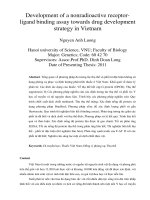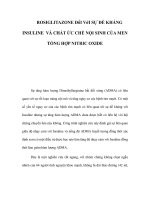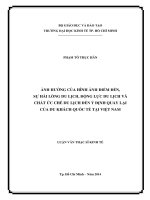Nguy cơ tương tác giữa opioid và chất ức chế monoamine oxidase (MAOIs) là gì?
Bạn đang xem bản rút gọn của tài liệu. Xem và tải ngay bản đầy đủ của tài liệu tại đây (109.5 KB, 9 trang )
Medicines Q&As
What is the risk of interaction between opioids and monoamine
oxidase inhibitors (MAOIs)?
Prepared by UK Medicines Information (UKMi) pharmacists for NHS healthcare professionals
Before using this Q&A, read the disclaimer at />Date prepared: June 2017
Background
The interaction between MAOIs and opioids can take on either of two distinctive forms (1-4):
CNS excitation - serotonin syndrome
CNS depression - opioid toxicity
The BNF advises that the use of opioids in a patient who has taken an MAOI in the last two weeks
should be avoided if possible and only undertaken with caution and appropriate monitoring, due to
possible CNS depression or excitation (4). Many summaries of product characteristics for both opioids
and MAOIs advise avoidance of, or caution with, the combination. However, not all opioid analgesics
have been reported to cause problems and safe use of some combinations has been described.
Serotonin Syndrome
Serotonin syndrome can be described as a drug-induced excess of serotonergic activity at central
receptors (3). The characteristic symptoms fall into 3 main areas, although features from each group
may not be seen in all patients (4,5):
1. Neuromuscular hyperactivity; tremor, clonus, myoclonus, hyper-reflexia and (in the advanced
stage) rigidity.
2. Autonomic hyperactivity; diaphoresis, fever, tachycardia and tachypnoea.
3. Altered mental status; agitation, excitement and (in the advanced stage) confusion.
Clinical features can range from mild and transient to severe and life-threatening (3,4,6). Fatalities
have occurred (1). The onset of serotonin syndrome is often within minutes of altering a drug regimen,
although there have also been some delayed reactions. The occurrence and severity do not appear to
be dose related, but are due to the extent and duration of the rise in intrasynaptic serotonin (3).
Controversially, other sources have claimed there is a dose-effect relationship to the reaction (5).
Current thinking favours the spectrum concept of ‘serotonin toxicity’ as a continuum of serotonergic
effects (7). For a review of serotonin syndrome see UKMi Q&A What is serotonin syndrome and which
medicines cause it? (7).
Drugs Associated with Serotonin Syndrome
There is a risk of serotonin syndrome when serotonergic drugs are combined. Serotonergic classes of
drugs include MAOIs, tricyclic antidepressants, selective serotonin re-uptake inhibitors (SSRIs),
opioids (including the structurally related over-the-counter cough suppressants dextromethorphan and
pholcodine), 5-HT1-receptor agonists (“triptans”), weight reduction agents, some anti-emetics, drugs of
abuse and herbal products (6).
MAOIs that are irreversible or non-selective or that inhibit MAO subtype A, are strongly associated
with severe cases of serotonin syndrome (6). The selective inhibitor of monoamine oxidase type B,
selegiline, may also pose problems at high doses as its selectivity starts to diminish (3). In addition to
medicines deliberately used for their inhibition of MAO, a number of other drugs have MAOI activity,
including linezolid, tedizolid (4) and methylthioninium chloride (“methylene blue”) (8).
Available through Specialist Pharmacy Service at
www.sps.nhs.uk
Medicines Q&As
There is evidence that some opioid analgesics act as serotonin re-uptake inhibitors: fentanyl (and
congeners), pethidine, tramadol, methadone, and dextromethorphan (1,5). Additionally, it has been
suggested that tramadol releases serotonin (9). Morphine, codeine, oxycodone and buprenorphine
are not thought to be inhibitors of serotonin reuptake (1,5).
Opioid Toxicity
Some reactions involving MAOIs and opioid analgesics present as cases of opioid toxicity (respiratory
depression, hypotension, coma) instead of serotonin syndrome (1,3). Opioid toxicity is caused by
CYP450 inhibition by the MAOI leading to accumulation of opioid (3). This reaction is primarily
associated with morphine, but serious adverse effects are predicted to occur with the concurrent use
of other opioids (such as buprenorphine, codeine, diamorphine, dihydrocodeine, dipipanone,
hydromorphone, meptazinol, methadone and oxycodone) and the MAOIs, although there do not
appear to be any published reports of an interaction (1).
Answer
There are few systematic studies of interactions between an MAOI and an opioid. These are not
recent and measure different outcomes from those now included in the definition of serotonin
syndrome (3,5,6). Because of the lack of study data and the difficulty in defining and diagnosing
serotonin syndrome, it is difficult to draw any definite conclusions (1,2). Almost all information is based
on numerous case reports –see the table on page 4 for a summary.
A study comparing intramuscular injections of water, pethidine and morphine found no significant
difference between rises in blood pressure in patients receiving phenelzine or isocarboxazid (or other
MAOIs that are no longer available) (2). This study was not powered and the low number of patients
(n=15) was the reason given by the authors for the lack of a significant difference (2). Gillman points
out that due to a lack of understanding and a definition of serotonin syndrome, the parameters
assessed were inappropriate and the results of this study do not reflect the clinical importance of the
pethidine interaction seen in case reports (5).
Opioids that should usually be avoided in combination with a MAOI
Given the widespread availability of several suitable alternative drugs, the combination of the following
drugs with an MAOI (or reversible MAOI) should usually be avoided, including in the 14 day period
following the discontinuation of an irreversible MAOI:
Pethidine (1,3,5,6,10-15)
The interaction between pethidine and MAOIs is based on several case reports (1). The reaction may
be idiosyncratic and the severity is unpredictable, but it is potentially fatal. Dose-dependence has not
been verified. The use of test doses has been suggested, but seems unnecessary given the
availability of alternatives to both pethidine and MAOIs. A literature review of the interaction between
linezolid and a range of serotonergic drugs (including pethidine) suggests a serotonin syndrome
incidence of 0.24-4% and a variable onset time of the interaction (<1 to 20 days) after coadministration (10). Due to the lack of evidence and potential harm, the combination should be
avoided (1,3).
Dextromethorphan (1,3,5,6,11-15)
Fatalities have occurred in patients taking dextromethorphan with phenelzine; the related cough
suppressant, pholcodine, is predicted to interact similarly (1).
Tramadol (1,3,5,8,9,13,15)
Case reports, including a fatality, have been reported with tramadol and MAOIs (1). Animal studies
have shown increased deaths with concurrent administration of tramadol and MAOIs (8). Seizure
potential should be borne in mind if given together as this combination may increase the risk of
seizures (1,8).
Available through Specialist Pharmacy Service at
www.sps.nhs.uk
Medicines Q&As
Methadone (5,13,16-18)
Methadone is a weak serotonin reuptake inhibitor which has been implicated in serotonin toxicity
when given alongside an MAOI (5,13). Some sources state concurrent use of MAOIs as an absolute
contraindication for methadone (16). However, published reports of interactions between MAOIs and
methadone are lacking (1,17) and concurrent use has been reported without mishap (3,18).
.
Fentanyl (1,5,9,12-15,18)
Fentanyl is known to be serotonergic (15). There is conflicting information in the literature regarding
the risk of an interaction with MAOIs. Some reviewers have stated that it is safe when co-administered
with MAOIs (12-14,18) and there are reports of the uneventful use of this combination (see table).
However, there have been case reports of serotonin toxicity including fatalities with this combination
(1,9,15). If concomitant use is unavoidable, strict monitoring for serotonin syndrome is necessary (15).
Tapentadol (3)
Although there are currently no case reports, it may be prudent to avoid the combination of tapentadol
and a MAOI, as this opioid also inhibits the reuptake of noradrenaline (3).
Opioids that may be used cautiously in combination with a MAOI
Morphine, codeine, oxycodone and buprenorphine have been described as the preferred opioids for
use in patients taking MAOIs, because they are not thought to be inhibitors of serotonin reuptake (1,
5,13). Some sources suggest morphine is the strong opioid of choice in patients receiving MAOIs and
requiring emergency or elective surgery (3,18,19). Case reports describe the uneventful use of
alfentanil and remifentanil in patients taking MAOIs (1,3). These fentanyl congeners have short halflives and may be expected to be safer because they are quickly reversible (5).
However, any opioid should be used with caution in patients taking an MAOI, making use of test
doses and frequent titration of small doses against pain. The patient should be closely monitored for
signs and symptoms of CNS and respiratory depression (3,12,17). One author suggests initiating
opioids at a third or half the normal dose (17).
When assessing the risk of combining an opioid with an MAOI, it is important to consider any other
serotonergic drugs the patient is taking. One literature review suggested that use of a variety of
opioids (e.g. fentanyl, morphine and hydromorphone) plus any antidepressant with serotonergic
activity, might be a risk factor for the development of serotonin syndrome. Co-administration of
linezolid (an antimicrobial) increases the risk (20). The authors therefore suggest that opioid use with
linezolid should be minimised (20).
Summary
The use of most MAOIs with opioids is contraindicated or cautioned by manufacturers. There
is conflicting information in the literature about the degree of risk of an interaction.
Some opioid analgesics are associated with a risk of serotonin syndrome in combination with
MAOIs due to their serotonergic properties. Other combinations may result in opioid toxicity
due to CYP450 enzyme inhibition by the MAOI.
Any trials conducted in this field are not recent and measured different outcomes from those
now included in the definition of serotonin syndrome. This means almost all information is
based on case reports.
Given the widespread availability of several suitable alternative drugs, the combination of
dextromethorphan, methadone, pethidine, tramadol, fentanyl or tapentadol with an MAOI
should usually be avoided, including in the 14 day period following the withdrawal of an
irreversible MAOI.
Available through Specialist Pharmacy Service at
www.sps.nhs.uk
Medicines Q&As
Morphine, codeine, oxycodone and buprenorphine are alternative opioids for patients
receiving MAOIs, though starting at a low dose and titrating cautiously against clinical
response is advised. Blood pressure and the signs and symptoms of CNS and respiratory
depression should be monitored closely.
Available through Specialist Pharmacy Service at
www.sps.nhs.uk
Medicines Q&As
Diamorphine
Dipipanone
Dihydrocodeine
Fentanyle
Alfentanilf
Remifentanilf
Hydromorphone
Meptazinol
Methadone
Morphineb
Oxycodone
Papaveretum
Pentazocine
S3
OS1
O1
O1
O1
OS2
OS1
OS1
O1
O1
OS1
O2
O1
O1
O1
a,d,h,i
O1
O1
S3,
2
OS1
O1
O1
O1
OS1
OS1
OS1
O1
O1
OS1
O1
O1
O1
O1
O1
O1
S1
OS1
O1
O1
O1
O1
S3
OS1
OS1
O1
O1
OS1
O1
O1
O1
O1
Moclobemide
O1
O1
S3
OS1
O1
O1
O1
OS1
OS1
OS1
O1
O1
OS1
O1
O1
O1
O1
b,j
O1
O1
S3
S3
O3
O1
O1
O1
OS2
S3
OS2
OS2
O1
O1
OS1
O3,2
S3,2
O1
O1
O1
O1
O1
S1
OS1
O1
O1
O1
OS1
OS1
OS1
O1
O1
OS1
O1
O1
O1
O1
O1
O1
S1
OS1
O1
O1
O1
OS1
OS1
OS1
O1
O1
OS1
O1
O1
O1
O1
O1
O1
S1
OS1
O1
O1
O1
OS1
OS1
OS1
O1
O1
OS1
O1
O1
O1
O1
O1
O1
S1
OS1
O1
O1
O1
OS2
S3
OS2
OS1
O1
O1
O2
S1
O3,2
O1
O1
O1
Linezolid
e
Methylthioninium
chloride (methylene blue)
d
Phenelzine
S2
O1
S3
O1
OS1
S3
O1
S3,2
O1
Tramadolg,h
Dextropropoxyphene
O1
Tapentadol
Dextromethorphani
O1
Pholcodine
Codeine
Isocarboxazid
Pethidinea,c,j
Buprenorphine
The table below represents a summary of evidence for the use of various MAOI and opioid combinations:
S1
OS1
OS1
S1
OS1
O1
S3
S1
OS1
OS1
S1
OS1
S1
OS1
S1
OS1
OS1
S1
OS1
OS1
S1
OS1
OS1
S1
OS1
OS1
O1
S3
O1
S3
c
Rasagiline
MAOI-B
c
Selegeline
MAOI-B
d
Tedizolid
e,j
Tranylcypromine
Available through Specialist Pharmacy Service at
www.sps.nhs.uk
OS1
O1
S3
OS1
S3,2
O1
Medicines Q&As
Specific Advice
a
Serotonin syndrome has been reported with this combination (1,21). Unless there are facilities
available for close observation and monitoring for blood pressure, linezolid should not be administered
to patients on pethidine (1).
b
Various sources recommend using morphine as an alternative to pethidine in patients receiving
MAOIs. Hypotensive reactions have been seen but are of a different character to the severe reaction
seen with pethidine and appear to be rare (1). It is advised to start with a low initial dose of morphine
and titrate to clinical response (3,12,17). A case of serotonergic adverse effects has been reported in
a patient given phenelzine and morphine (22).
c
Although selective for MAO type B, selegiline and rasagiline lose their selectivity when used at
increasing doses, posing the risk of serotonin syndrome. A case of fluctuating stupor and agitation,
with muscle rigidity, sweating and a raised temperature has been reported when pethidine was used
with selegiline (1). Rasagiline is expected to interact similarly (1). Some manufacturers contra-indicate
the use of selegiline with pethidine or other opioids (23).
d
As moclobemide is a reversible MAOI, it is unlikely to interact 24 hours after it has been stopped (1).
Linezolid and tedizolid are also reversible MAOIs (4).
e
Fentanyl has been described as a weak serotonin reuptake inhibitor (22). Whilst fentanyl has been
given to patients taking MAOIs without problems (1,3) cases have been reported of serotonergic type
reactions associated with concurrent use (1,5,9). A death associated with fentanyl in a patient taking
tranylcypromine has been cited in a review paper as evidence of a fatal serotonin syndrome reaction
O Combination may result in opioid toxicity
3 Case reports of harm
induced by fentanyl use (5). However,
S Combination may result in serotonin syndrome
2 Case reports of safe use
the authors of the original case report
OS Combination may result in either/both
1 No case reports identified
stated that there was insufficient
evidence to make any definitive conclusion concerning the safety of fentanyl in patients taking MAOIs
(5,24). Another case report links serotonin syndrome to the concurrent use of fentanyl and
methylthioninium (methylene blue) (25). While causality is not confirmed, this report highlights the
importance of being aware of the potential for reactions even when low doses of drugs, used routinely
in the perioperative setting, are given. Advice from manufacturers reflects this conflicting information.
Some contraindicate the use of fentanyl within two weeks of taking an MAOI (26) while others suggest
use of fentanyl alongside MAOIs should be cautious and state that serotonin syndrome may occur
within the recommended dose (27). This combination should only be used if there is no suitable
alternative and patients should be closely monitored (24).
f
As alfentanil and remifentanil have shorter half-lives than fentanyl, they would be expected to be
safer (5).
g
Tramadol has serotonergic effects and manufacturers contraindicate concurrent use with MAOIs
(28). Whilst the clinical evidence for an interaction is limited, Stockley recommends close monitoring
for serotonin syndrome if used together (1).
h
A review of postmarketing data identified a case of suspected serotonin syndrome in a patient
receiving linezolid, tramadol and paroxetine, all of which are known to inhibit serotonin re-uptake (29).
If the combination of linezolid and tramadol is clinically necessary, the patient should be monitored for
signs of serotonin syndrome (4).
i
Two fatal case reports of hyperpyrexia and coma (similar to serotonin syndrome) with the
combination of dextromethorphan and phenelzine. Three other serious reactions reported with the
Available through Specialist Pharmacy Service at
www.sps.nhs.uk
Medicines Q&As
combination of dextromethorphan and either phenelzine and isocarboxazid (1). However, some of
these cases were complicated by overdose and the use of multiple interacting drugs (1). There is no
pharmacokinetic interaction between dextromethorphan and linezolid, but there is one case report of
concurrent use resulting in serotonin syndrome (1).
j
Severe, toxic reactions including loss of consciousness and death have been reported following a
single dose of pethidine in patients taking tranylcypromine or phenelzine respectively (1,30).
Limitations
Opioid analgesics and MAOIs are defined as per the BNF latest edition
In addition, methylthioninium chloride (methylene blue) included as an MAOI
In addition, dextromethorphan and pholcodine included as opioids
References
1. Preston CL, editor. Stockley’s Drug Interactions. London: Pharmaceutical Press. Electronic version
accessed via www.medicinescomplete.com on 12/04/2017.
2. Evans-Prosser CDG. The use of pethidine and morphine in the presence of monoamine oxidase
inhibitors. Br J Anaesth 1968; 40: 279-82.
3. Brayfield A, editor. Martindale: The Complete Drug Reference. London: Pharmaceutical Press.
Accessed via www.medicinescomplete.com on 12/04/2017.
4. Joint Formulary Committee. British National Formulary (online) London: BMJ Group and
Pharmaceutical Press. Accessed via on 12/04/2017.
5. Gillman PK. Monoamine oxidase inhibitors, opioid analgesics and serotonin toxicity. Br J Anaesth
2005; 95: 434-41.
6. Boyer EW, Shannon M. Current Concepts: The Serotonin Syndrome. N Engl J Med 2005; 352:
1112-1120.
7. McKie J. What is serotonin syndrome and which medicines cause it? Accessed via
on
26/04/2017.
8. McEvoy GK, editor. AHFS Drug Information. Accessed via www.medicinescomplete.com on
26/4/2017.
9. Barann M, Stamer UM, Lyutenska M. Effects of opioids on human serotonin transporters. Arch
Pharmacol (2015) 388:43-49.
10. Ramsey TD, Lau TTY, Ensom, MHH. Serotonergic and adrenergic drug interactions associated
with linezolid: a critical review and practical management approach. Ann. Pharmacother. 2013;
47:543-559.
11. Lecrubier Y. Risk-benefit assessment of newer versus older monoamine oxidase (MAO) inhibitors.
Drug Safety 1994,10:292-300.
12. Rossiter A, Souney PF. Interaction between MAOIs and opioids: pharmacologic and clinical
considerations. Hosp Formul 1993, 28: 692-698.
13. Lum CT, Stahl SM. Opportunities for reversible inhibitors of monoamine oxidase-A (RIMAs) in the
treatment of depression. CNS Spectrums 2012; 17:107-120.
14. Rapaport MH. Dietary restrictions and drug interactions with monoamine oxidase inhibitors: the
state of the art. J Clin Psychiatry 2007, 68(suppl 8):42-46.
15. Drugdex Drug Evaluations for linezolid Micromedex® 2.0 (healthcare series): (Last modified:
27/01/2015) Accessed via on 21/06/2017.
16. Nicholson AB. Methadone for cancer pain (review). Cochrane Database Syst Rev. 2007;
17(4):CD003971.
17. Bazire S. Psychotropic Drug Directory 2016. Lloyd-Reinhold Publications Limited.
Available through Specialist Pharmacy Service at
www.sps.nhs.uk
Medicines Q&As
18. Stack CG, Rogers P, Linter SPK. Monoamine oxidase inhibitors and anaesthesia. Br J
Anaesth1988, 60:222-227.
19. Pedavelly S, Fugate JE, Rabinstein AA. Serotonin syndrome in the intensive care unit: Clinical
presentations and precipitating medications. Neurocrit Care 2014; 21:108-113.
20. Huang V, Gortney, JS. Risk of serotonin syndrome with concomitant administration of linezolid and
serotonin agonists. Pharmacother. 2006; 26:1784-1793.
21. Das PK, Warkentin DI, Hewko R, et al. Serotonin syndrome after concomitant treatment with
linezolid and meperidine. Clin Infect Dis 2008; 46: 264-5.
22. Mateo-Carrasco H., Muñoz-Aguilera E. M., García-Torrecillas J. M.et al. Serotonin syndrome
probably triggered by a morphine–phenelzine interaction. Pharmacotherapy (2015) 35: e102–e105.
doi:10.1002/phar.1581
23. Summary of Product Characteristics. Zelapar. Cephalon UK. Last revised Aug 2015. Accessed via
www.medicines.org.uk/emc on 22/06/2017.
24. Noble W.H, Baker, A. MAO inhibitors and coronary artery surgery: a patient death. Can J Anaesth
(1992) 39: 1061. doi:10.1007/BF03008376
25. Adler AR, Charnin JA, Quraishi SA. Serotonin Syndrome: The potential for a severe reaction
between common perioperative medications and selective serotonin reuptake inhibitors. A&A Case
Reports. 2015;5:156-9. doi: 10.1213/XAA.0000000000000217
26. Summary of Product Characteristics. Actiq 200mcg Lozenges. Teva Pharma. Last revised May
2017. Accessed via www.medicines.org.uk/emc on 22/06/2017.
27. Summary of Product Characteristics. Abstral. Kyowa Kirin Ltd. Last revised May 2016. Accessed
via www.medicines.org.uk/emc on 22/06/2017.
28. Summary of Product Characteristics. Zydol 50mg Capsules. Grunenthal Ltd. Last revised July
2016. Accessed via www.medicines.org.uk/emc on 22/06/2017.
29. Lawrence KR, Adra M, Gillman PK. Serotonin toxicity associated with the use of linezolid: a review
of postmarketing data. Clin Infect Dis. 2006; 42:1578-83.
30. Summary of Product Characteristics. Nardil Tablets. Kyowa Kirin Limited. Last revised Feb 2017.
Accessed via www.medicines.org.uk/emc on 23/06/2017.
Quality Assurance
Prepared by
Jill Forrest, South West Medicines Information, University Hospitals Bristol NHS Foundation Trust.
(Based on earlier work by Matthew Jones).
Date Prepared
June 2017
Checked by
Julia Kuczynska, South West Medicines Information, University Hospitals Bristol NHS Foundation
Trust
Date of check
6th July 2017
Search strategy
Embase: ((exp “MONOAMINE OXIDASE INHIBITOR”/ OR TEDIZOLID/ OR LINEZOLID/ OR
“METHYLENE BLUE”/) + (exp”OPIATE AGONIST”/ OR OPIATE/ OR exp “FENTANYL
DERIVATIVE”/ OR PENTAZOCINE/ OR PHOLCODINE/)) [Limit to Publication Year 20152017]
Available through Specialist Pharmacy Service at
www.sps.nhs.uk
Medicines Q&As
Embase: ((exp “MONOAMINE OXIDASE INHIBITOR”/ OR TEDIZOLID/ OR LINEZOLID/ OR
“METHYLENE BLUE”/) + exp “NARCOTIC AGENT”/) [Limit to Publication Year DT 20152017]
Medline: ((exp “MONOAMINE OXIDASE INHIBITORS”/ OR “METHYLENE BLUE”/ OR
LINEZOLID/ OR (tedizolid).ti,ab OR (rasagiline).ti,ab) + (exp “ANALGESICS, OPIOID”/ OR
DEXTROMETHORPHAN/ OR (dipipanone).ti,ab OR (dihydrocodeine).ti,ab OR
(pholcodine).ti,ab OR (tapentadol).ti,ab)) [Limit to Publication Year 2015-2017]
Medline: "(exp NARCOTICS/ AND (exp "MONOAMINE OXIDASE INHIBITORS"/ OR
"METHYLENE BLUE"/ OR LINEZOLID/ OR (tedizolid).ti,ab OR (rasagiline).ti,ab)) [Limit to
Publication Year DT 2015-2017]"
Medline: ((“SEROTONIN SYNDROME”/ AND exp “DRUG INTERACTIONS”/) AND exp
“MONOAMINE OXIDASE INHIBITORS”/) [Limit to Publication Year DT 2015-2017]
Medline: *”SEROTONIN SYNDROME”/ [Limit to Publication Year DT 2014-2017]
PubMed: (("monoamine oxidase inhibitors"[Pharmacological Action] OR "monoamine oxidase
inhibitors"[MeSH Terms] OR ("monoamine"[All Fields] AND "oxidase"[All Fields] AND
"inhibitors"[All Fields]) OR "monoamine oxidase inhibitors"[All Fields]) AND ("analgesics,
opioid"[Pharmacological Action] OR "analgesics, opioid"[MeSH Terms] OR ("analgesics"[All
Fields] AND "opioid"[All Fields]) OR "opioid analgesics"[All Fields] OR "opioids"[All Fields]))
AND ("2012/04/07"[PDat] : "2017/04/05"[PDat])
Internet Search: NICE Evidence Search via www.evidence.nhs.uk (opioid “monoamine oxidase
inhibitors”)
In-house database/resources
Available through Specialist Pharmacy Service at
www.sps.nhs.uk









